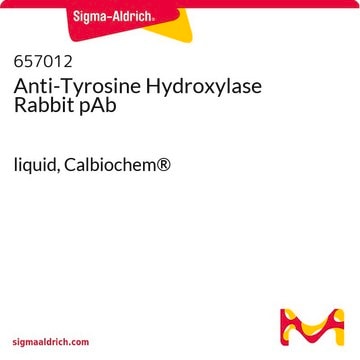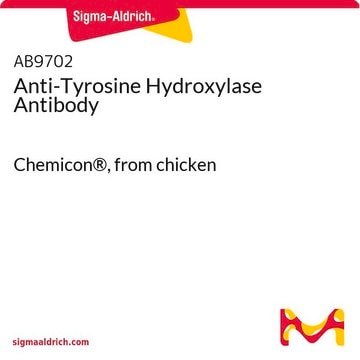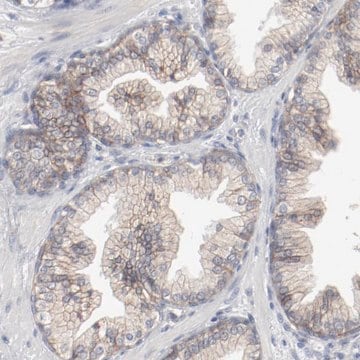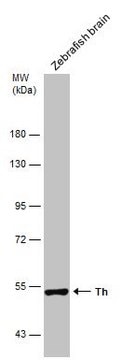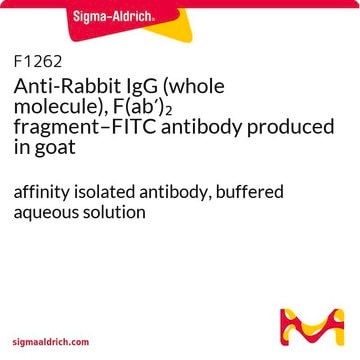AB152
Anti-Tyrosine Hydroxylase Antibody
Chemicon®, from rabbit
Synonym(s):
Tyrosine 3-hydroxylase, Tyrosine 3-monooxygenase, tyrosine hydroxylase, TH
About This Item
Recommended Products
biological source
rabbit
Quality Level
antibody form
affinity isolated antibody
antibody product type
primary antibodies
clone
polyclonal
purified by
affinity chromatography
species reactivity
human, mollusk, feline, ferret, Aplysia (marine mollusc), rat, squid, Drosophila, mouse
manufacturer/tradename
Chemicon®
technique(s)
ELISA: suitable
immunofluorescence: suitable
immunohistochemistry (formalin-fixed, paraffin-embedded sections): suitable
immunoprecipitation (IP): suitable
western blot: suitable
NCBI accession no.
UniProt accession no.
shipped in
dry ice
target post-translational modification
unmodified
General description
Specificity
Immunogen
Application
A previous lot of this antibody was uesd at 1:100-1:1,000 dilution, 4°C, for 1-3 days. Stains both fresh frozen and paraffin embedded tissue samples by indirect immunofluorescence and immunoperoxidase.
Immunofluorescence:
A previous lot of this antibody was used at 1:100-1:1,000 dilution.
Immunoprecipitation:
A previous lot of this antibody was used on Immunoprecipitation.
ELISA:
A previous lot of this antibody was used in ELISA.
Optimal dilutions must be determined by the end user.
Neuroscience
Neurotransmitters & Receptors
Neuronal & Glial Markers
Quality
Western Blot Analysis:
1:1000 dilution of this lot detected tyrosine hydroxylase on 10 μg of PC12 lysates.
Target description
Physical form
Storage and Stability
Analysis Note
POSITIVE CONTROL: Brain (corpus striatum, sympathetic nerve terminals) and adrenal glands.
NEGATATIVE CONTROL: Liver.
Legal Information
Disclaimer
Not finding the right product?
Try our Product Selector Tool.
Storage Class Code
10 - Combustible liquids
WGK
WGK 1
Certificates of Analysis (COA)
Search for Certificates of Analysis (COA) by entering the products Lot/Batch Number. Lot and Batch Numbers can be found on a product’s label following the words ‘Lot’ or ‘Batch’.
Already Own This Product?
Find documentation for the products that you have recently purchased in the Document Library.
Customers Also Viewed
Articles
Explore the basics of working with antibodies including technical information on structure, classes, and normal immunoglobulin ranges.
Explore the basics of working with antibodies including technical information on structure, classes, and normal immunoglobulin ranges.
Antibodies combine with specific antigens to generate an exclusive antibody-antigen complex. Learn about the nature of this bond and its use as a molecular tag for research.
Antibodies combine with specific antigens to generate an exclusive antibody-antigen complex. Learn about the nature of this bond and its use as a molecular tag for research.
Protocols
Tips and troubleshooting for FFPE and frozen tissue immunohistochemistry (IHC) protocols using both brightfield analysis of chromogenic detection and fluorescent microscopy.
Our team of scientists has experience in all areas of research including Life Science, Material Science, Chemical Synthesis, Chromatography, Analytical and many others.
Contact Technical Service



